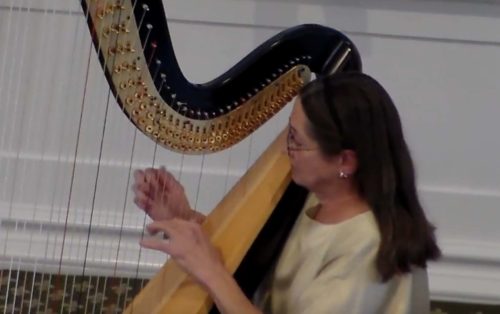
Long time Vermont harpist brings her delicate touch to Handel’s Concerto for Harp in B Major.
This piece first appeared in The Vermont Standard.
When concert goers walk into the Woodstock Town Hall Theater on Sunday night, they’ll see the familiar u-shaped arrangement of folding chairs. Musicians, all clad in black, will be adjusting and tuning, as normal, with ear to string or mouthpiece to lips. The unusual in this orchestral evening will be glowing under the center stage lights, a six foot tall instrument with gracefully curved neck, broad, sharply sloped soundboard, and deftly carved column: the harp. After the Concertmaster stands and the strings and woodwinds and horns fall silent, Heidi Soons will walk across the stage and take her seat at the instrument she’s played for more than forty years.
The Vermont Symphony Orchestra (VSO) comes to Woodstock on October 3 for this year’s version of its “Made In Vermont” concert tour. The twenty-six piece orchestra will perform a program that VSO Executive Director Alan Jordan says was selected “to feature some of our extraordinary musicians.” Soons begins with Handel’s delicate and celestial Concerto for Harp in B Major, composed in 1736, but still, somehow familiar to today’s ears. Rachmaninoff’s Vocalise follows. Written for voice by the avant-garde-for-his-time Russian composer in 1912, the VSO presents it as a piece for the French horn, featuring its own Shelagh Abate. The first half concludes with CPE Bach’s spirited Concerto for Flute in D Minor, which spotlights the energetic and talented VSO flautist Albert Brouwer as both soloist and conductor.
A contemporary piece, It is Time, by Burlington-based composer Don Jamison opens the second half of the evening. Jamison himself introduces the piece, ruminating on his inspiration, the short poem Autumn Day. The concert concludes with the Symphony Number 29 in A Major by the ebullient, trendsetting, eighteenth century composer, Wolfgang Amadeus Mozart.
The 400 seat Town Hall Theater, which first hosted the VSO in December of 1937, is a venue that affords its audience the unique opportunity to hear a full orchestra in an intimate setting. Patrons will be able to see the harp’s strings shiver, watch violinsts’ fingers glide across their fingerboards, and perhaps hear the bassist draw breath in the pauses between numbers.
When Soons leans back her harp to play Handel’s Concerto, the piece she performs won’t be exactly the concerto that Handel composed. Marcel Grandjany, the late, acclaimed twentieth century harpist and composer, revised the concerto for the modern harp, incorporating some of his own techniques. The instrument of Handel’s time was simpler and smaller, Soons says, without the mechanisms that allow today’s musicians to play sharps and flats. As a result, the original piece was a bit thinner in its textures. As Soons’ slim, agile fingers simultaneously pluck and muffle strings to produce Grandjany’s signature harmonics, she’ll be playing the piece note for note as he intended. Grandjany taught the method to his students, including Soons’ childhood teacher Jane Weidensaul, who in turn taught it to her.
That Soons learned to play the harp was a “happy accident.” At age eleven she’d gone with her father “to somebody’s house, oh, to sign some papers or something,” she says. A beautiful and imposing harp sat in the living room; the “somebody” was noted harpist Weidensaul, a teacher at both the Julliard and Manhattan Schools of Music. The two sat down and played a few notes. Shortly after, Soons began lessons, as well as a life-long passion for the harp. “It’s lovely, it’s just my favorite thing to do,” she says of playing, “I enjoy watching peoples’ reactions to the sound of it.”
Just as the concert’s first half pieces showcase Soons, Abate, and Brouwer, Principal Guest Conductor Anthony Princiotti headlines its concluding selection, Mozart’s Symphony. At twenty-some minutes, the piece is the longest of the concert, and it engages the fullest instrumentation of the evening. There are violins, violas, cellos and a bass, as well as a flute, oboes, and French horns. It gives the audience a chance to see that the role of the conductor reaches far beyond waving hands to a beat. Princiotti, in his satiny black jacket with Nehru collar, is fun to watch as he shapes the character of the performance with bold, athletic movements.
As with all its concerts, the VSO hopes through the “Made in Vermont Series” to bring classical music to a broad and diverse audience. Anyone can enjoy the harp’s silvery, melodic notes or the rich, mellow tones of the French horn. Harpist Soons observes that, in general, “There are connections with music that people don’t even realize they have” before they actually listen to it. Director Jordan agrees. While the VSO aims to demystify the music of the old masters with interesting program notes and a congenial conductor who talks with the audience from the stage, Jordan hopes that listeners will rely on intuition to experience each piece. “The music speaks for itself,” he says, “Sit back, open your mind, and enjoy.”
